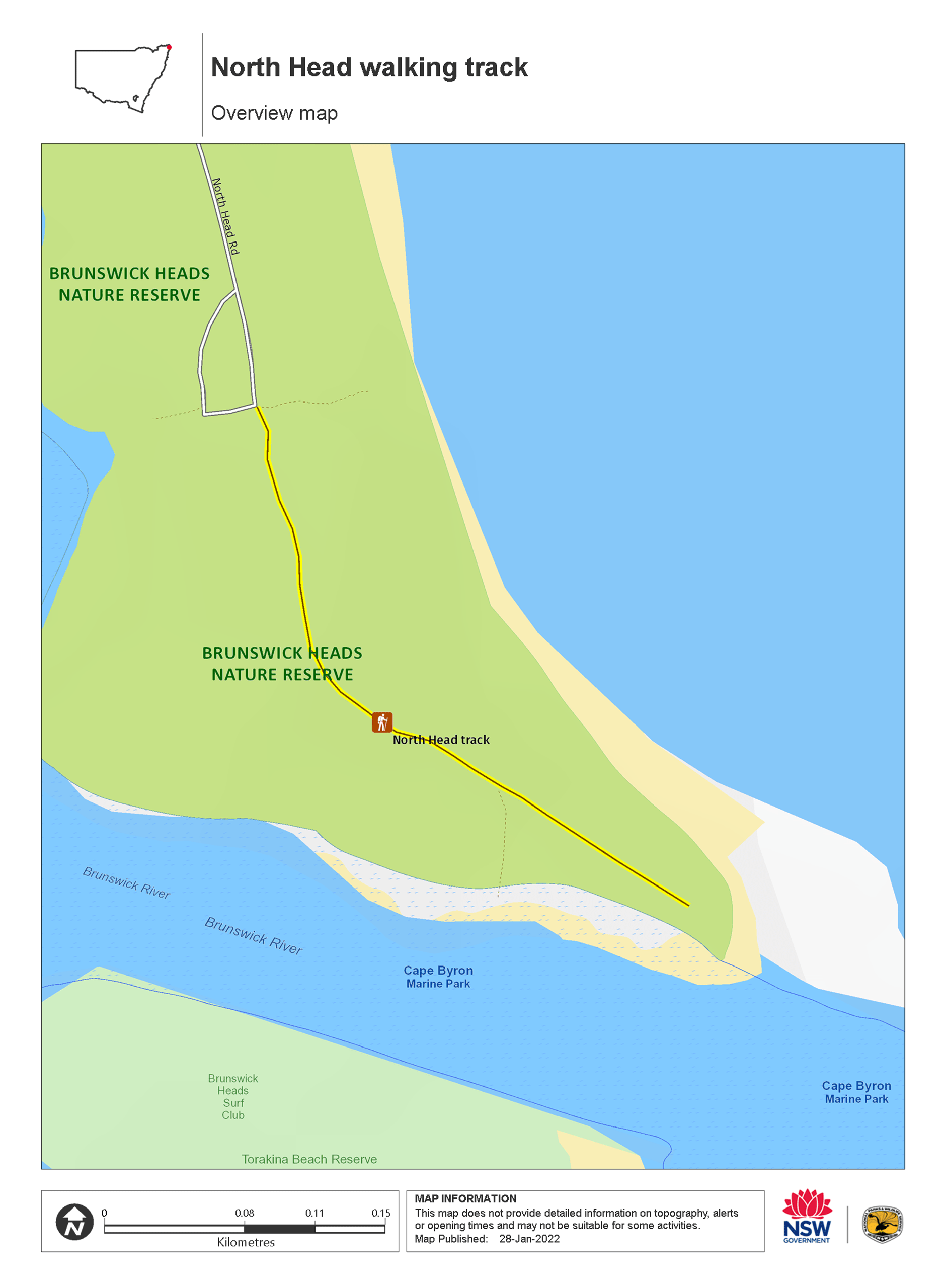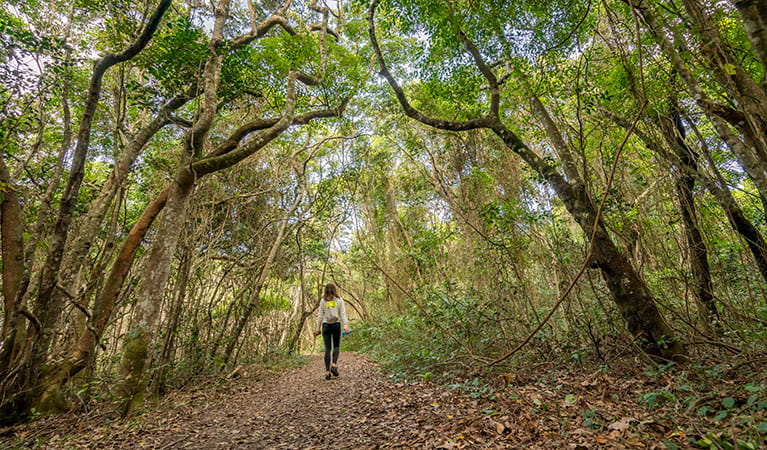North Head walking track
Brunswick Heads Nature Reserve
Overview
A short easy walking route on North Head walking track through coastal rainforest to Brunswick River with scenic views and chances for picnicking, whale watching and birdwatching.
- Accessibility
- Medium
- Distance
- 0.7km return
- Time suggested
- 15 - 30min
- Grade
- Grade 2
- What to
bring - Drinking water, hat, sunscreen
- Please note
- Remember to take your binoculars if you want to bird watch or whale watch.
It’s a short, easy stroll on North Head walking track from the carpark down through a lovely section of endangered littoral rainforest to the mouth of Brunswick River. Tear yourself away from scenic ocean views and head down this trail for a change of scenery. You may spot a goanna along the way, or a harmless carpet python.
For birdwatchers, there are plenty of feathered friends to feast your eyes upon as you walk, such as rainbow bee-eaters. As the name suggests, these birds are brilliantly marked and, although they will eat all sorts of insects, particularly relish a good bee and are immune to the sting. Keep an eye out for this multi-coloured beauty during the warmer months and have your binoculars handy.
Two other short tracks also lead from North Head carpark to the ocean beach and to mangrove-lined Marshalls Creek.
Map

Map legend

Local alerts
For the latest updates on fires, closures and other alerts in this area, see https://www.nationalparks.nsw.gov.au/things-to-do/walking-tracks/north-head-walking-track/local-alerts
General enquiries
- National Parks Contact Centre
- 7am to 7pm daily
- 1300 072 757 (13000 PARKS) for the cost of a local call within Australia excluding mobiles
- parks.info@environment.nsw.gov.au
Park info
- in Brunswick Heads Nature Reserve in the North Coast region
Brunswick Heads Nature Reserve is always open but may have to close at times due to poor weather or fire danger.
Visitor info
All the practical information you need to know about North Head walking track.
Track grading
Features of this track
Distance
0.7km return
Time
15 - 30min
Quality of markings
Clearly sign posted
Experience required
No experience required
Gradient
Flat
Quality of path
Formed track: The walk is 1m-wide and hard-packed ground until you reach the breakwall, at which point the track becomes sandy with steps to the riverbank.
There may be points where the track narrows slightly due to natural features such as vegetation, rocks and tree roots.
Steps
Occasional steps: There are no steps along most of the walk. As you near the end of the track where the path forks, there are 9 timber steps that lead down to the river if you take the right path. The left path is step-free.
Getting there and parking
Get driving directions
North Head track is in the North Head precinct of Brunswick Heads Nature Reserve. To get there, park in North Head carpark and follow the signs.
Road quality
The unsealed road is in poor condition with a lot of holes for the last kilometre so drive very slowly and carefully.
- Unsealed roads
Vehicle access
- 2WD vehicles
Weather restrictions
- All weather
Parking
There's parking in a hard-packed ground carpark at the start of the track. It can be a busy place on weekends, so parking may be limited.
Best times to visit
There are lots of great things waiting for you in Brunswick Heads Nature Reserve. Here are some of the highlights.
Spring
During this season humpback whales accompanied by new calves and migratory shorebirds can be seen. Look out for bar-tailed godwits, which undertake the longest non-stop migratory flight of any bird in the world.
Winter
Late June and early July is the peak time to see humpback whales migrating north to mate and calve in tropical waters. New Brighton Beach and the north wall of Brunswick River are the best viewing spots.
Weather, temperature and rainfall
Summer temperature
Average
20°C and 27°C
Highest recorded
35.1°C
Winter temperature
Average
12°C and 19.5°C
Lowest recorded
3.3°C
Rainfall
Wettest month
March
Driest month
September
The area’s highest recorded rainfall in one day
350.4mm
Facilities
Drinking water is not available in this area, so it’s a good idea to bring your own.
Toilets
There are accessible non-flush toilets at North Head carpark where the walk begins.
The toilets have a timber ramp with handrails that leads to the entrance. There may be a lip to get from the hard-packed ground onto the timber ramp.
- Non-flush toilets
Maps and downloads
Accessibility
Disability access level - medium
North Head walking track is flat and mostly step-free. It's 1m-wide and hard-packed ground along its length.
There are some points along the track where people with reduced mobility may need assistance:
- As you near the end of the track, there's a fork in path. If you take the right path, the track becomes sandy and there there are 9 timber steps that lead down to the river. There are no steps along the left path.
- There may be points where the track narrows slightly due to natural features such as vegetation, rocks and tree roots.
There are accessible toilets at the start of the walk at the carpark.
Permitted
Fishing
A current NSW recreational fishing licence is required when fishing in all waters.
Prohibited
Pets
Pets and domestic animals (other than certified assistance animals) are not permitted. Find out which regional parks allow dog walking and see the pets in parks policy for more information.
Smoking
NSW national parks are no smoking areas.
Learn more
North Head walking track is in Brunswick Heads Nature Reserve. Here are just some of the reasons why this park is special:
A home by the beach

Forty-three threatened animal species have been recorded in and around the reserve. Humpback whales can be seen off the coast during the migration period, and the world's smallest fruit bat called common blossom, which is just 6cm long, can also be seen. Other animals include the grey-headed flying fox, wallum froglet, long-nosed potoroo and koala. Critically endangered loggerhead turtles and vulnerable green turtles sometimes nest on New Brighton Beach. Brunswick Heads Nature Reserve is also home to threatened pied oystercatchers, sooty oystercatchers and beach stone-curlews.
- Brunswick Heads guided beach fishing adventures Visit beautiful Brunswick Heads Nature Reserve for a guided fishing excursion with Wilderness Adventures. Whether you’re a seasoned angler honing your technique or just want a relaxing day on the beach, their experts have an experience custom-made for you.
- Brunswick River picnic area Brunswick River picnic area is a great place to enjoy this peaceful reserve, with scenic views, easy access to fishing and plenty of birdwatching opportunities.
- North Head walking track A short easy walking route on North Head walking track through coastal rainforest to Brunswick River with scenic views and chances for picnicking, whale watching and birdwatching.
Land of plenty

Brunswick Heads Nature Reserve lies within the traditional land of the Bundjalung people. The area, once a campground, continues to provide a ready source of food such as dugum (pipis) and julum (fish). Harrys Hill is known as "Durrungbil', which means "water rat". When viewed from the south side of Brunswick River at the right angle, the profile of that water rat can clearly be seen.
Safe haven

Thirty-six threatened plant species have been recorded in the reserve. Brunswick Heads is a stronghold for many endangered rainforest plants that are either at the southern limit of their distribution or not found in many other places in New South Wales. These include Queensland xylosma, scented acronychia, durobby and white lace flower. The reserve also supports six endangered ecological communities (EEC), including littoral rainforest, swamp sclerophyll forest and coastal saltmarsh.
- Brunswick River picnic area Brunswick River picnic area is a great place to enjoy this peaceful reserve, with scenic views, easy access to fishing and plenty of birdwatching opportunities.
- North Head walking track A short easy walking route on North Head walking track through coastal rainforest to Brunswick River with scenic views and chances for picnicking, whale watching and birdwatching.
Plants and animals protected in this park
Animals
-

Humpback whale (Megaptera novaeangliae)
The humpback whale has the longest migratory path of any mammal, travelling over 5000km from its summer feeding grounds in Antarctica to its breeding grounds in the subtropics. Its playful antics, such as body-rolling, breaching and pectoral slapping, are a spectacular sight for whale watchers in NSW national parks.
-

White-bellied sea eagle (Haliaeetus leucogaster)
White-bellied sea eagles can be easily identified by their white tail and dark grey wings. These raptors are often spotted cruising the coastal breezes throughout Australia, and make for some scenic bird watching. Powerful Australian birds of prey, they are known to mate for life, and return each year to the same nest to breed.
-

Grey-headed flying-fox (Pteropus poliocephalus)
The grey-headed flying fox is Australia's largest native bat, with a wingspan up to 1m. This threatened species travels up and down south-eastern Australia and plays a vital role in pollinating plants and spreading seeds in our native forests.

